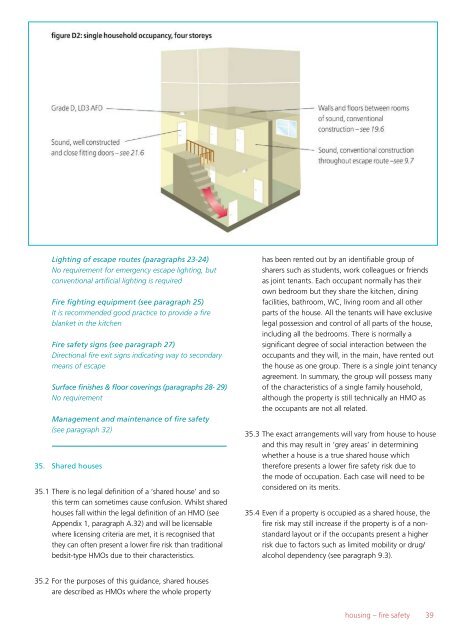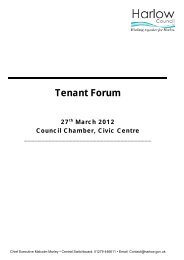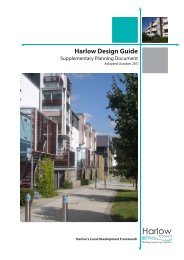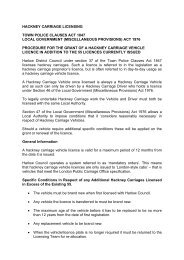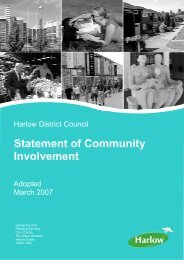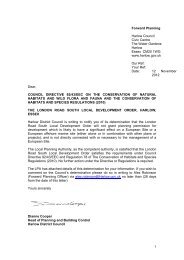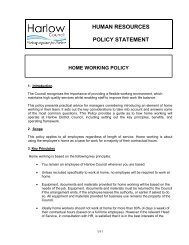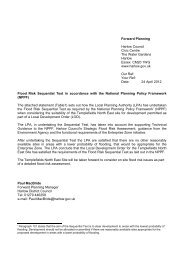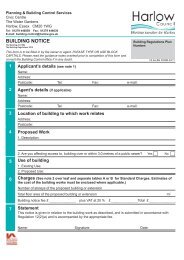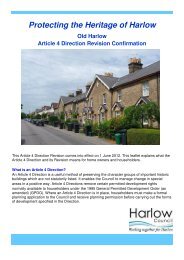HMO fire safety guidance - Harlow Council
HMO fire safety guidance - Harlow Council
HMO fire safety guidance - Harlow Council
Create successful ePaper yourself
Turn your PDF publications into a flip-book with our unique Google optimized e-Paper software.
Lighting of escape routes (paragraphs 23-24)<br />
No requirement for emergency escape lighting, but<br />
conventional artificial lighting is required<br />
Fire fighting equipment (see paragraph 25)<br />
It is recommended good practice to provide a <strong>fire</strong><br />
blanket in the kitchen<br />
Fire <strong>safety</strong> signs (see paragraph 27)<br />
Directional <strong>fire</strong> exit signs indicating way to secondary<br />
means of escape<br />
Surface finishes & floor coverings (paragraphs 28- 29)<br />
No requirement<br />
Management and maintenance of <strong>fire</strong> <strong>safety</strong><br />
(see paragraph 32)<br />
35. Shared houses<br />
35.1 There is no legal definition of a ‘shared house’ and so<br />
this term can sometimes cause confusion. Whilst shared<br />
houses fall within the legal definition of an <strong>HMO</strong> (see<br />
Appendix 1, paragraph A.32) and will be licensable<br />
where licensing criteria are met, it is recognised that<br />
they can often present a lower <strong>fire</strong> risk than traditional<br />
bedsit-type <strong>HMO</strong>s due to their characteristics.<br />
has been rented out by an identifiable group of<br />
sharers such as students, work colleagues or friends<br />
as joint tenants. Each occupant normally has their<br />
own bedroom but they share the kitchen, dining<br />
facilities, bathroom, WC, living room and all other<br />
parts of the house. All the tenants will have exclusive<br />
legal possession and control of all parts of the house,<br />
including all the bedrooms. There is normally a<br />
significant degree of social interaction between the<br />
occupants and they will, in the main, have rented out<br />
the house as one group. There is a single joint tenancy<br />
agreement. In summary, the group will possess many<br />
of the characteristics of a single family household,<br />
although the property is still technically an <strong>HMO</strong> as<br />
the occupants are not all related.<br />
35.3 The exact arrangements will vary from house to house<br />
and this may result in ‘grey areas’ in determining<br />
whether a house is a true shared house which<br />
therefore presents a lower <strong>fire</strong> <strong>safety</strong> risk due to<br />
the mode of occupation. Each case will need to be<br />
considered on its merits.<br />
35.4 Even if a property is occupied as a shared house, the<br />
<strong>fire</strong> risk may still increase if the property is of a nonstandard<br />
layout or if the occupants present a higher<br />
risk due to factors such as limited mobility or drug/<br />
alcohol dependency (see paragraph 9.3).<br />
35.2 For the purposes of this <strong>guidance</strong>, shared houses<br />
are described as <strong>HMO</strong>s where the whole property<br />
housing – <strong>fire</strong> <strong>safety</strong> 39


